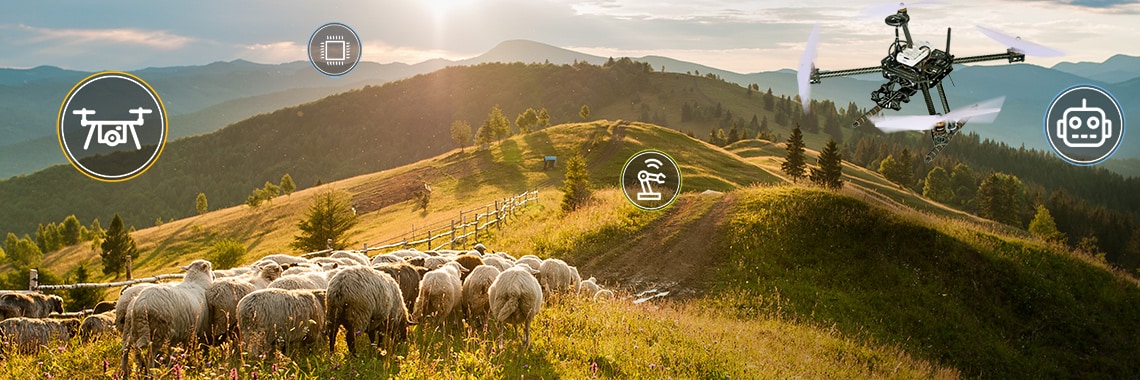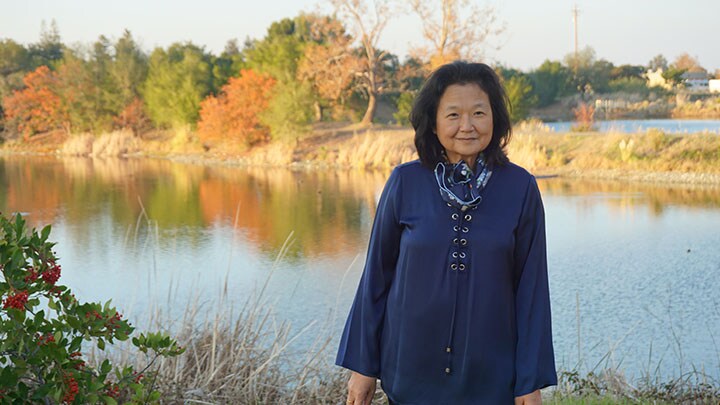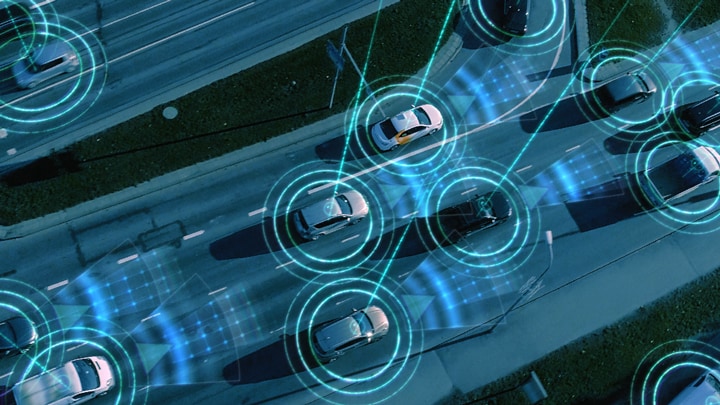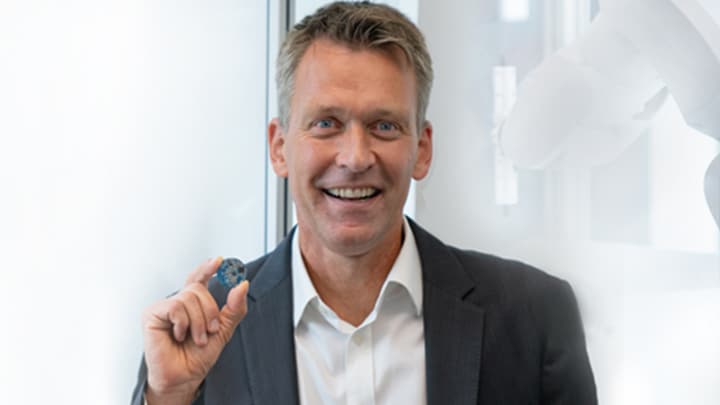Humanity’s growth and success over the last few thousand years is arguably due
to our ability to feed ourselves. However, the world's population is
forecast to grow from 7.6 billion to 9.8 billion by 2050, and agricultural
production is expected to
increase by 70%
over that time. Whether it’s shifting cultivation in the tropics, commercial
grain farming in Europe or tea plantations in Asia, we need to make all the
different types of agriculture, food production and its supply chain as
efficient as possible without damaging habitats and the diversity of nature.
We also need to meet new increasing demands for organic food.
Balancing the need for new supporting tech must take into account the millions
of people who rely on the food industry for their income. Innovative use of
technology is essential in meeting this challenge. Farmers
must be more targeted
to meet increased demand without exhausting natural resources. Today, drones
and rovers are already making this possible, but these tools have just started
to be used in increasingly innovative and productive ways.
Taking to the Skies or Roaming the Earth
There are many ways to enhance food production. For example, farms typically
cover large areas. So far, the best way of getting high-quality images of
fields and crops has been using satellite imagery – but this is expensive.
Instead, drones provide excellent pictures at a far lower cost and with much
more flexibility to change what is being investigated at short notice. The
same can be said about drones monitoring fish farming operations or searching
in the sea, both for large commercial ships that previously might have used
helicopters for scouting and individuals in small boats.
Drones and rovers can be used to analyze soil, helping to determine where
different seeds should be planted and then monitoring the crops as they grow.
They can work effectively with other technologies, such as the internet of
things (IoT). For instance, sensor networks based on small sensors can gather
environmental data, such as humidity, air quality and specific gases, which is
used to help decide where drones are most needed on a farm. As an example,
local field pollutions by e.g., kerosene or waste can be detected and trigger
measures to ensure a good growth.
Autonomous vehicles are also starting to become popular in farming, with
remote monitoring enabling multiple tractors or other machines to be
controlled by a single operator, helped by one or more drones.
IDTechEx has forecast that more than 500,000 autonomous tractors will be sold by 2023.
Without a driver, there are many new ways the technology could go. How about a
mini ‘tractor’, a small rover with specific tasks? This could pick fruit,
identify pest levels or even release predator insects. Even when this is done
methodically, one pest at a time, the costs are low. Imagine 100 solar-powered
rovers working day and night tirelessly, scanning up and down the crops to
pick off individual pests one at a time. Beyond farming, robotic submarines
are helping manage and maintain fish farms and drones are surveying water
temperature and quality.
These drones and rovers could be vital in helping us find our way to a
greener, more efficient future for sustainable food ecosystems. HoverGames
solutions come both in direct and indirect support of food ecosystems.
Delivering a soil test kit or sample is just as interesting a use case as
monitoring a crop directly or helping to pollinate a nut tree. Last year’s
winning HoverGames 2 entry, SCAREcrow, aimed to identify and scare away wild animals that could harm
livestock and crops. It used a ground-based base station running AI processes
to analyze drone image data and direct them to ‘herd’ wildlife away.
How Your Coding Skills Can Make a Difference
HoverGames Challenge 3 invites you to show NXP how drones and rovers can make
our food ecosystem more sustainable. Can your code help farmers grow more
food, reduce wastage from pests and disease, reduce the resources required and
impact on the environment? Can you help people in the developing world to
apply the latest technology?
By participating in NXP’s HoverGames Challenge 3, you can decide how to use
our developer kits to help achieve a sustainable farm and food ecosystem. Your
application could be in a desert, over the oceans or in the tropical
rainforest. Your project could also focus on our changing climate and how it
might affect food production or look at how we can better protect animals and
insects to maintain biodiversity. The options are endless.
The HoverGames drone and Buggy3 rover developer kits are open and modular, and
components such as sensors and communications devices can be added to bring
your idea to life. This year brings exclusive early access to NXP’s NavQPlus
companion computer built around the
NXP i.MX 8M Plus applications processor, and incorporating ROS2 enablement for building drones and rovers with more
intelligence and decision-making capabilities. Additionally, building and
deploying state-of-the-art ML applications at the edge is enabled with NXP’s
eIQ® machine learning software development environment: a
comprehensive set of ML workflow tools, inference engines, optimized libraries
and neural network compilers designed to ease ML application development.
In addition, we have teamed up with Bosch Sensortec, adding their
BME688 AI-enabled environmental gas sensor to the developer kits. These
compact and low-power sensors can detect a broad range of gases in the part
per billion (ppb) range. The gas scanner can be customized for sensitivity,
selectivity, data rate and power consumption and can be trained to a specific
application using the
Bosch BME AI-Studio tools: desktop software for training specific algorithms, mobile app
for testing and labelling and server software for deploying it to sensor
networks in the field. For example, in a drone or rover application, the
presence of volatile sulfur compounds (VSCs) can be used as an indicator for
bacteria growth in food crops. Bosch Sensortec also supports the challenge by
offering a special sustainability award to honor the most effective
sensor-based solution that pursues sustainability goals.
Think Creatively
We’re looking for something that can make a difference, whether it’s growing
more food, reducing environmental impact of supporting a wildlife habitat.
Make sure you stay focused on your goal: how can you use your idea to achieve
a more sustainable food ecosystem? You don’t necessarily need to demonstrate
your idea fully at a real farm or another setting. Ideally, an NXP HoverGames
drone or Buggy3 rover should be able to carry out its mission as autonomously
as possible. With the help of your code, we just need to see what it could do.
Suppose your idea is about monitoring crop health by visual inspection. In
that case, your testing setup should demonstrate how the drone or rover would
find its way to the right location in the correct field, how it would take
suitable photos, and how the images would be analyzed on the drone or rover
using machine learning and a select few could be transmitted to a central
system for additional review.
However, it’s not just about using cameras to monitor farming. How could you
use drones or rovers to help find and gather food that grows wild? Maybe it
could be distributing vaccines to farmers to inoculate their animals or
sending back samples for remote diagnosis. Wherever your idea takes you, make
sure you can show us how it works in practice.
Think about the different pieces of technology you might need, whether it’s an
adaptation of an existing application or something totally new. Doing more
with less is also exciting. Sometimes, low costs can allow a simple idea to
scale up much more realistically. Imagine what can be accomplished with 100
vehicles, each doing a straightforward thing repeatedly, 24/7. Keep in mind
that unconventional ideas will get special attention because radical solutions
may be needed for the challenges that sustainable food ecosystems face. In
addition, Bosch Sensortec offers a special sustainability award to honor the
most effective sensor-based solution that pursues sustainability goals.
With your NXP HoverGames entry, show us how you will harness the power of
vision and sensing with AI and machine learning to push the boundaries and
bring innovation to help with the sustainable food ecosystem.
This is the third NXP HoverGames Challenge. Read more about the winners of the
first two challenges,
Fighting Fires with Flyers
and
Drones to Help in Pandemics.
You can subscribe to the podcast on
Spotify
and
iTunes.




